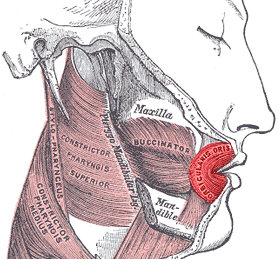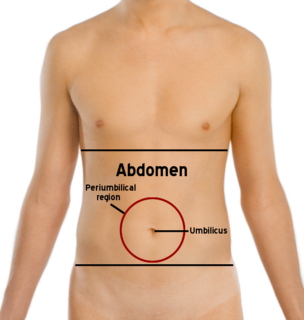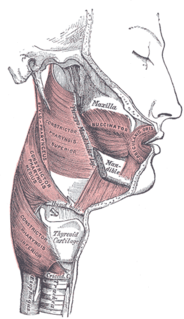
The buccinator crest (Latin crista buccinatoria) is a bony crest of the human mandible, that passes from the base of the coronoid process to the area of the third molar. [1] The alveolar border of the buccinator muscle attaches upon it. [2]

The buccinator crest (Latin crista buccinatoria) is a bony crest of the human mandible, that passes from the base of the coronoid process to the area of the third molar. [1] The alveolar border of the buccinator muscle attaches upon it. [2]

The sacrum, in human anatomy, is a large, triangular bone at the base of the spine that forms by the fusing of the sacral vertebrae (S1–S5) between ages 18 and 30.

The trumpeter swan is a species of swan found in North America. The heaviest living bird native to North America, it is also the largest extant species of waterfowl, with a wingspan of 185 to 250 cm. It is the American counterpart and a close relative of the whooper swan of Eurasia, and even has been considered the same species by some authorities. By 1933, fewer than 70 wild trumpeters were known to exist, and extinction seemed imminent, until aerial surveys discovered a Pacific population of several thousand trumpeters around Alaska's Copper River. Careful reintroductions by wildlife agencies and the Trumpeter Swan Society gradually restored the North American wild population to over 46,000 birds by 2010.

The buccinator is a thin quadrilateral muscle occupying the interval between the maxilla and the mandible at the side of the face. It forms the anterior part of the cheek or the lateral wall of the oral cavity.

In human anatomy, the orbicularis oris muscle is a complex of muscles in the lips that encircles the mouth. It is a sphincter, or circular muscle, but it is actually composed of four independent quadrants that interlace and give only an appearance of circularity.

The facial artery is a branch of the external carotid artery that supplies structures of the superficial face.

A buccina or bucina, anglicized buccin or bucine, is a brass instrument that was used in the ancient Roman army, similar to the cornu. An aeneator who blew a buccina was called a "buccinator" or "bucinator".

The buccal nerve is a nerve in the face. It is a branch of the mandibular nerve and transmits sensory information from skin over the buccal membrane and from the second and third molar teeth. Not to be confused with the buccal branch of the facial nerve which transmits motor information to the buccinator muscle.

The abdomen is the part of the body between the thorax (chest) and pelvis, in humans and in other vertebrates. The abdomen is the front part of the abdominal segment of the torso. The area occupied by the abdomen is called the abdominal cavity. In arthropods it is the posterior tagma of the body; it follows the thorax or cephalothorax.

The ilium is the uppermost and largest part of the hip bone, and appears in most vertebrates including mammals and birds, but not bony fish. All reptiles have an ilium except snakes, although some snake species have a tiny bone which is considered to be an ilium.

In vertebrates, the pubic region is the most forward-facing of the three main regions making up the coxal bone. The left and right pubic regions are each made up of three sections, a superior ramus, inferior ramus, and a body.

The pterygoid plexus is a venous plexus of considerable size, and is situated between the temporalis muscle and lateral pterygoid muscle, and partly between the two pterygoid muscles.

The buccal artery is a small artery in the head. It branches off the second part of the maxillary artery and supplies the cheek and buccinator muscle.

The transverse facial artery is an artery that branches from the superficial temporal artery and runs across the face.

The buccal branches of the facial nerve, are of larger size than the rest of the branches, pass horizontally forward to be distributed below the orbit and around the mouth.

The pterygomandibular raphe is a ligamentous band of the buccopharyngeal fascia. It is attached superiorly to the pterygoid hamulus of the medial pterygoid plate, and inferiorly to the posterior end of the mylohyoid line of the mandible. It connects the buccinator muscle in front to the superior pharyngeal constrictor muscle behind. It resists mandibular realignment.

The buccal space is a fascial space of the head and neck. It is a potential space in the cheek, and is paired on each side. The buccal space is superficial to the buccinator muscle and deep to the platysma muscle and the skin. The buccal space is part of the subcutaneous space, which is continuous from head to toe.

The facial muscles are a group of striated skeletal muscles supplied by the facial nerve that, among other things, control facial expression. These muscles are also called mimetic muscles. They are only found in mammals, although they derive from neural crest cells found in all vertebrates. They are the only muscles that attach to the dermis.

The buccinator lymph node or nodes are one or more lymph nodes placed on the Buccinator opposite the angle of the mouth.
The supreme nasal concha or highest nasal concha is a nasal concha (turbinate) that occurs in some cases. It is shaped like a seashell and found on the posterosuperior part of the lateral nasal wall. It lies on the medial surface of the labyrinth of ethmoid above the superior nasal concha. This makes it the highest the nasal conchae, and the highest of three on the ethmoid bone. It is often no more than a small, simple crest protruding from the nasal wall.
A crest is any of various anatomical features appearing as a raised point or ridge, most prominently those on the head or back of an animal.